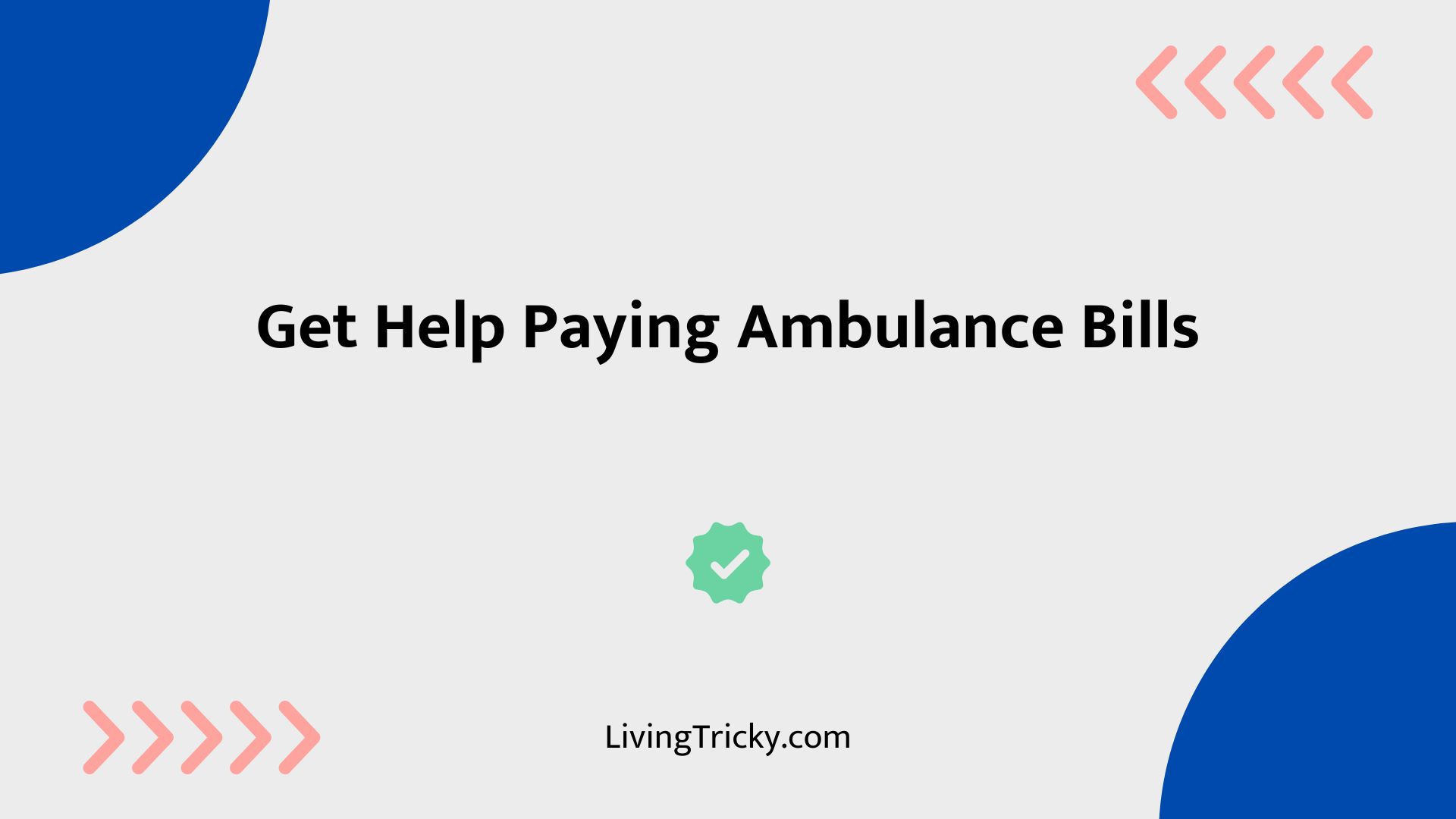You’re not alone if you’re struggling to pay your ambulance bill – in the US, over 40% of adults have received a surprise medical bill, with ambulance services being a leading contributor. If you’re facing a hefty ambulance bill, know that there are options to help alleviate the financial strain.
From financial assistance programs to negotiating with providers, there are ways to reduce your burden. But first, let’s take a closer look at the complexities of ambulance billing and insurance coverage – you might be surprised at what you’re eligible for.

Key Takeaways
- Investigate financial assistance options, such as negotiating with providers or seeking local government programs, to reduce your ambulance bill.
- Verify your insurance coverage to minimize out-of-pocket expenses and ensure you have a robust health insurance plan that includes ambulance services.
- Check your insurance policy ahead of time to know in-network ambulance providers and reduce costs, and ask EMTs to take you to in-network hospitals.
- Look into your hospital’s financial assistance program, which may offer charity care and non-charity discounts to eligible patients, to reduce your bill.
- Negotiate a payment plan with your ambulance provider to spread the cost over several months or years to make the bill more manageable.
Understanding Ambulance Bills and Insurance Coverage
When a medical emergency strikes, the last thing on your mind is the cost of the ambulance ride that’s about to save your life.
However, the average ambulance bill can be staggering, ranging from $1,200 to $45,000 depending on the type of emergency and transport method. Ambulance bills can be staggering, ranging from $1,200 to a whopping $45,000 depending on the emergency and transport method.
Insurance coverage for ambulance services varies widely, and even with health insurance, payment isn’t guaranteed. Differently-abled individuals and elderly folks, in particular, may face higher risks of out-of-pocket expenses due to specialized transport needs.
If the responding ambulance is out of network, you may be left with a significant bill.
Understanding your insurance plan’s coverage for ambulance services, especially if you’re relying on Health Services to navigate the costs, can help you prepare for the potential financial burden.
Financial Assistance Options and Negotiating Bills
Since ambulance bills can be overwhelming, it’s essential to investigate financial assistance options and negotiation strategies to mitigate the cost.
You can examine various alternatives to reduce your financial burden.
- Verify you have a robust health insurance plan that includes coverage for ambulance services to minimize out-of-pocket expenses.
- Negotiate the ambulance bill directly with the provider, as some may be willing to offer discounts or settlements.
- Look into financial assistance programs that can cover unpaid coinsurance, deductibles, and non-covered services, or investigate local government programs that offer free or low-cost ambulance services.
Surprise Billing Protections and Preventing Surprise Bills
When you’re dealing with an ambulance bill, it’s essential to understand your insurance coverage to prevent out-of-network bills.
You can take steps to avoid surprise bills by knowing which ambulance providers are in-network and negotiating costs with the ambulance company.
Understanding Insurance Coverage
You may think you’re protected from surprise bills, but ground ambulance services are a notable exception.
As of January 1, 2022, new billing protections restrict excessive out-of-pocket costs, but ground ambulance services are exempt.
To avoid surprise ambulance bills, it’s essential to understand your insurance coverage.
- Check your insurance policy ahead of time to know in-network ambulance providers and reduce costs.
- Ask EMTs to take you to in-network hospitals to minimize costs.
- Understand that Medicare may cover long-distance ambulance transport if deemed medically necessary, helping you make informed decisions.
Preventing Out-of-Network Bills
The No Surprises Act, enacted to restrict excessive out-of-pocket costs, has significant limitations, particularly in terms of ground ambulance services.
You’re still at risk of receiving surprise bills from out-of-network ambulance providers. To minimize this risk, you should check your insurance policy ahead of time to know in-network ambulance providers and hospitals. This can help you avoid balance billing, a common practice in the ambulance industry.
Additionally, you may want to examine the Ambulance Supplemental Payment Program, which can provide financial assistance in certain situations, especially helpful for low-income individuals and solo parents who may struggle with unexpected medical expenses.
Government aid initiatives are also available to assist in covering these costs, ensuring you don’t have to bear the financial burden alone.
Negotiating Ambulance Costs
While knowing your insurance policy and in-network ambulance providers can help prevent surprise bills, it’s not a foolproof solution.
You may still receive an unexpected ambulance bill. In this case, negotiating with the ambulance company can help reduce your out-of-pocket costs.
- Ask your insurance company to intervene on your behalf, as they may have more influence in negotiating a better rate.
- Contact the ambulance company directly to discuss possible discounts or payment plans.
- Consider seeking assistance from a medical billing advocate who can help you navigate the negotiation process.
The Consequences of Non-Payment and Special Considerations
Failing to pay an ambulance bill can trigger a cascade of consequences, starting with a series of escalating notices and late fees.
Missed ambulance payments spark a chain reaction of penalties, fees, and damaged credit.
If you’re unable to pay, you’ll receive follow-up notices 30-90 days after the initial bill, followed by pre-collections warnings 90-120 days later.
If you still haven’t paid, your debt will be transferred to a collections agency 120+ days after the initial bill. This can negatively impact your credit report, as ambulance services often provide non-charity care.
Be aware that some states have specific consumer protection laws for ambulance billing, but federal protections like the No Surprises Act don’t apply to ground ambulance services.
Debt Relief Options and Resources
You can examine various debt relief options to manage your ambulance bill.
These options can help alleviate the financial burden and provide a more manageable payment solution.
- Look into your hospital’s financial assistance program, which may offer charity care and non-charity discounts to eligible patients.
- Investigate cost recovery programs that can help reduce your ambulance bill.
- Negotiate a payment plan with your ambulance provider to spread the cost over several months or years.
TASPP – Texas Ambulance Supplemental Payment Program
The Texas Ambulance Supplemental Payment Program (TASPP) offers a vital reimbursement opportunity for EMS agencies to bridge the gap between their service costs and Medicaid reimbursement for individuals without Medicare, Medicaid, or commercial insurance. By applying for TASPP, you can recover a portion of revenue that would otherwise be lost.
| TASPP Benefits | Your Advantage |
|---|---|
| Reduces revenue loss | Improves financial stability |
| Provides reimbursement | Helps with cost recovery |
| Supports EMS agencies | Strengthens business operations |
Investing in the TASPP process is a smart way to reduce revenue loss and improve financial stability.
How to Apply for TASPP Reimbursement
To apply for TASPP reimbursement, you must first guarantee your ambulance provider meets the eligibility requirements, including having a valid Charity Care or Financial Assistance Policy per HFMA guidelines.
Next, you’ll need to submit a written application to the Texas Health and Human Services Commission (HHSC) Rate Analysis Department (HHSC-RAD) by mail, including a completed Ambulance Cost Report.
This application must be certified before the end of the federal fiscal year, September 30th, to be considered for reimbursement.
Eligibility Requirements
Ambulance providers seeking TASPP reimbursement must meet specific eligibility requirements, which involve having a Charity Care or Financial Assistance Policy that aligns with HFMA guidelines.
This necessary policy guarantees you provide necessary care to patients in need.
To qualify, you must:
- Be a governmental ambulance provider as defined in RULE §355.8600
- Maintain accurate and complete data for TASPP applications, including information about all runs, both charity care and non-charity care, throughout the year
- Submit a written application by mail to the Texas Health and Human Services Commission (HHSC) Rate Analysis Department (HHSC-RAD) to apply for TASPP reimbursement
Application Process
You’ll need to navigate a multi-step process to apply for TASPP reimbursement, which begins with preparing your application.
EMERGICON will provide the necessary data to your chosen 3rd party vendor, who’ll assist with completing the TASPP application. They’ll actively advocate for your agency to guarantee a smooth application process.
Once prepared, you’ll submit a written application by mail to the Texas Health and Human Services Commission (HHSC) Rate Analysis Department (HHSC-RAD) to enroll in the TASPP program. This effort can lead to additional revenue for your ambulance agency through cost recovery.
EMERGICON Support Throughout the TASPP Process
EMERGICON’s dedicated support team accompanies you throughout the TASPP process, guaranteeing a seamless experience from start to finish.
Expert guidance from start to finish, ensuring a seamless TASPP experience.
You’ll have a single point of contact to guide you through the complex process of cost recovery for uncompensated care. This support enables you to focus on what matters most – providing quality care to your patients.
- EMERGICON’s experts handle ambulance billing and claims submissions on your behalf, reducing administrative burdens.
- They certify compliance with regulations and industry standards, minimizing the risk of errors or denials.
- Throughout the TASPP process, you’ll receive regular updates and insights to optimize your cost recovery efforts.
TASPP Benefits and Importance
By leveraging the TASPP program, healthcare providers like yours can significantly augment their cost recovery efforts for uncompensated care.
You’ll benefit from improved ambulance billing and reimbursement processes, reducing the financial burden on your organization.
TASPP’s Supplemental Payment Program helps recover costs associated with uncompensated care, ensuring you receive fair compensation for your services.
Avoiding Surprise Charges and Ambulance Bills
When you’re suddenly in need of emergency medical transportation, the last thing on your mind is whether the ambulance service is in-network or not.
However, this oversight can lead to surprise ambulance bills. Since federal laws don’t protect you from out-of-network ground ambulance bills, you’re left vulnerable to balance billing.
- Check your insurance plan to see if it covers out-of-network ambulance services.
- Research local ambulance providers to find ones that are in-network with your insurance.
- If you’re unable to avoid an out-of-network ambulance service, try negotiating the bill with the provider or seeking assistance from a patient advocacy group.
The History of Ambulance Services and Average Bills
The ambulance industry has a long history, dating back to the late 19th century when horse-drawn carriages were used to transport patients.
Since then, ambulance companies have evolved to provide Emergency Medical Services (EMS), utilizing advanced medical transport technologies.
Today, you face high ambulance bills, with the average cost of patient transport reaching $1,200.
In severe cases, air transport costs can range from $20,000 to $45,000.
With varying insurance coverage, you’re left wondering who’ll foot the bill, making it essential to understand the ambulance industry’s history and average bills to navigate the complex medical transport landscape.
Who Pays for an Ambulance Ride and How to Negotiate
You’re likely wondering who’s responsible for footing the bill after an ambulance ride, especially considering the high costs involved.
In many cases, you’ll be on the hook for the costs of EMS services, especially if the ambulance provider is out of network with your insurance.
You may be responsible for EMS costs, especially if the ambulance provider is out of network with your insurance.
- If you reasonably can’t pay, it’s essential to negotiate with the provider, as they may be willing to cut a deal, such as a 40% discount for same-day payment.
- Keep in mind that the No Surprises Act doesn’t cover ground ambulances, leaving you vulnerable to surprise billing.
- Be prepared to communicate with your provider about reimbursement and customer payment options to avoid unexpected costs.
Financial Assistance for Ambulance Bills and Alternatives
When you’re struggling to pay an ambulance bill, you may be eligible for financial assistance programs like the Texas Ambulance Supplemental Payment Program (TASPP), which can help reduce the gap between EMS service costs and Medicaid reimbursement.
Additionally, many hospitals offer charity care programs that can cover ambulance bills, and negotiating the bill with the provider can also lower the amount you owe.
TASPP Reimbursement
Reimbursement opportunities like the Texas Ambulance Supplemental Payment Program (TASPP) can be a financial lifeline for EMS agencies struggling to recover revenue from providing care to uninsured or underinsured patients.
You can benefit from TASPP reimbursements, which help bridge the gap between service costs and Medicaid reimbursement. To be eligible, you’ll need a Charity Care or Financial Assistance Policy and submit a written application to the Texas Health and Human Services Commission.
- TASPP reimbursements are made on a case-by-case basis, providing additional revenue for EMS agencies.
- EMERGICON provides expert support throughout the TASPP process, maintaining accurate data and advocating for your agency.
- Investing in the TASPP process is a smart way to reduce revenue loss for EMS agencies.
Financial Assistance Options
Beyond TASPP, other financial assistance options are available to help patients struggling with ambulance bills.
You may be eligible for Charity Care or financial assistance programs offered by hospitals or local governments. These programs can cover or reduce ambulance bills.
Some local governments provide ambulance services free of charge to residents, offering alternative financial assistance options. Additionally, EMS agencies may have their own financial assistance policies in place.
It’s essential to research and investigate these options to minimize your financial burden. By doing so, you can receive the necessary assistance to navigate ambulance bill reimbursements.
Preventing Surprise Ambulance Bills and Legal Consequences
Surprise ambulance bills can be a major financial burden, and the consequences of not addressing them can be severe.
If you’re not prepared, you may face unexpected costs, even if you have insurance.
To prevent surprise ambulance bills, you should:
- Check your insurance coverage beforehand to guarantee the ambulance service is in-network.
- Ask your medical provider to arrange for in-network transportation when possible.
- Know your rights under the No Surprises Act, and advocate for yourself if you receive an unexpected bill.
Frequently Asked Questions
What Happens if I Can’t Pay an Ambulance Bill?
If you’re unable to pay an ambulance bill after a medical emergency, you’ll receive follow-up notices with late fees, and eventually, debt collection agencies will take over, potentially harming your credit score, unless you utilize insurance coverage and negotiate with the provider to reduce the financial burden.
Can You Do a Payment Plan for an Ambulance Bill?
You can examine ambulance financing options, such as emergency funding or medical loans, to manage your bill. Many providers offer financial assistance programs or payment plans, allowing you to negotiate a manageable repayment schedule.
Can You Negotiate Down an Ambulance Bill?
You can negotiate down an ambulance bill by reviewing ambulance costs, understanding your insurance coverage, and determining medical necessity to dispute balance billing, potentially reducing your financial responsibility.
What Is the Ambulance Response Program?
You’re likely referring to the Ambulance Response Program, which provides emergency medical services for medical emergencies, often with limited insurance coverage. This program isn’t a specific initiative, but rather a general term for emergency response services, which may be supported by government programs like TASPP.
Conclusion
As you navigate the labyrinth of ambulance billing, recall that you’re not alone. Like a lighthouse in the dark, financial assistance programs shine bright, guiding you through the treacherous waters of debt. Negotiate with providers, verify insurance coverage, and investigate alternatives to reduce your burden. Don’t let the weight of unpaid bills crush you – debt relief options and resources are within reach. Stay informed, stay vigilant, and you’ll find your way out of the financial wilderness, free from the shackles of ambulance debt.


